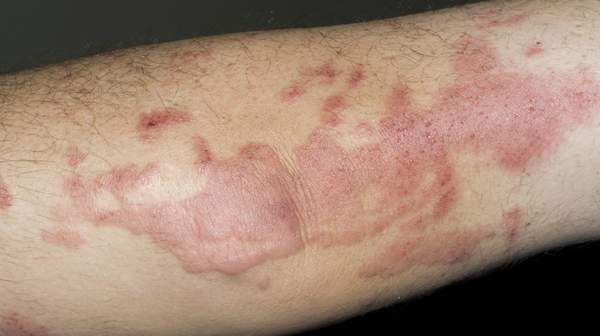
What's in this article?
What is Contact dermatitis
Contact dermatitis is a red, itchy rash caused by a substance that comes into contact with your skin. The rash isn’t contagious or life-threatening, but it can be very uncomfortable.
Possible causes include soaps, cosmetics, fragrances, jewelry, and plants, such as poison ivy or poison oak. Some people are exposed to substances at work that may cause contact dermatitis.
Causes of Contact dermatitis
Irritant dermatitis is the most common type. It’s caused by contact with acids, alkaline materials such as soaps and detergents, fabric softeners, solvents, or other chemicals. The reaction usually looks like a burn.
 Other irritants may include:
Other irritants may include:
- Cement
- Hair dyes
- Long-term exposure to wet diapers
- Pesticides or weed killers
- Rubber gloves
- Shampoos
Allergic contact dermatitis is caused by exposure to a substance or material to which you have become extra sensitive or allergic.
Common allergens include:
- Adhesives, including those used for false eyelashes or toupees
- Antibiotics such as neomycin rubbed on the surface of the skin
- Balsam of Peru (used in many personal products and cosmetics, as well as in many foods and drinks)
- Fabrics and clothing
- Fragrances in perfumes, cosmetics, soaps, and moisturizers
- Nail polish, hair dyes, and permanent wave solutions
- Nickel or other metals (found in jewelry, watch straps, metal zips, bra hooks, buttons, pocketknives, lipstick holders, and powder compacts)
- Poison ivy, poison oak, poison sumac, and other plants
- Rubber or latex gloves or shoes
Symptoms of Contact dermatitis
Contact dermatitis usually occurs on areas of your body that have been directly exposed to the substance. The reaction usually develops within minutes to hours of exposure to an irritating substance or allergen. The rash can last two to four weeks.
Signs and symptoms of contact dermatitis include:
- Red rash or bumps
- Itching, which may be severe
- Dry, cracked, scaly skin, if your condition is chronic
- Blisters, draining fluid and crusting, if your reaction is severe
- Swelling, burning or tenderness
The severity of the rash depends on:
- How long you’re exposed
- The strength of the substance that caused the rash
- Environmental factors, such as temperature, airflow and sweating from wearing gloves
- Your genetic makeup, which can affect how you respond to certain substances
Treatment of Contact dermatitis
Treatment includes washing with lots of water to remove any traces of the irritant that may remain on the skin. You should avoid further exposure to known irritants or allergens.
In some cases, the best treatment is to do nothing to the area.
Emollients or moisturizers help keep the skin moist, and also help skin repair itself. They protect the skin from becoming inflamed again. They are a key part of preventing and treating contact dermatitis.
Corticosteroid skin creams or ointments may reduce inflammation. Carefully follow the instructions when using these creams. Overuse, even of low-strength over-the-counter products, may cause a skin condition.
Along with, or instead of corticosteroids, your health care provider may prescribe drugs called tacrolimus ointment or pimecrolimus cream to use on the skin.
In severe cases, corticosteroid pills may be needed. You will start them on a high dose, which is tapered gradually over about 12 days. You may also receive a corticosteroid shot.
Wet dressings and soothing anti-itch (antipruritic) or drying lotions may be recommended to reduce other symptoms.





